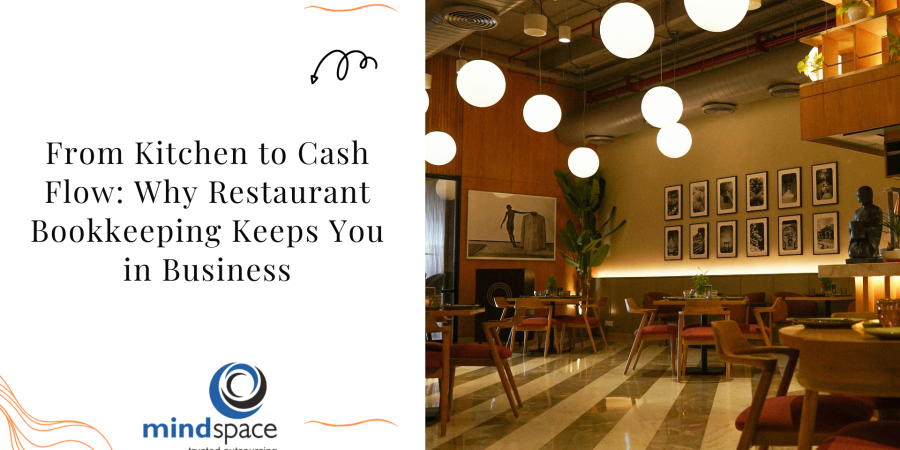From Kitchen to Cash Flow: Why Restaurant Bookkeeping Keeps You in Business
When people think of restaurants, they imagine sizzling cuisine, clinking glasses, and joyful conversations. What they often overlook, however, is the financial backbone that keeps these experiences possible: restaurant accounting and bookkeeping. Behind every five-star review and Instagram-worthy dish lies spreadsheets, balance sheets, profit and loss statements, and cash flow reports that ensure the restaurant stays open for business.
Running a restaurant isn’t just about perfecting recipes; it’s about making numbers work alongside the flavor. Whether you own a small café, a family diner, or manage a fine-dining chain, strong restaurant bookkeeping services are the secret recipe to long-term sustainability.
In this guide, we’ll explore why restaurant accounting matters, the common financial challenges restaurants face, essential bookkeeping practices, and modern tools that streamline restaurant finance.
Why Restaurants Struggle With Numbers
The restaurant industry is fast-paced and vibrant, but that same energy brings financial chaos if numbers aren’t tracked properly. Unlike many industries, restaurants deal with:
- High cash transactions – While credit cards dominate, many U.S. eateries still rely on cash, complicating reconciliation.
- Perishable inventory – Improper tracking of food supplies leads to waste and invisible profit leaks.
- Labor costs – Wages, overtime, tips, and benefits stack up quickly without effective payroll management.
- Seasonality and demand changes – Holidays, weekends, or even weather can make revenues swing dramatically.
- Thin profit margins – Just one misstep with food costs, pricing, or payroll can erase earnings.
Without accurate restaurant bookkeeping and accounting systems, restaurant owners risk staring at an empty bank account even with packed tables.
Bookkeeping: The Backbone of Restaurant Finances
Bookkeeping may not be glamorous, but it’s what ensures the business survives beyond the dinner rush. Essential practices for restaurant bookkeeping include:
- Daily sales tracking – Every dine-in, takeout, or delivery order must reconcile with POS reports.
- Expense recording – From vendor bills and utilities to uniforms and marketing, tracking small leaks prevents big losses.
- Payroll and tip management – Restaurants rely heavily on staff, so accurate payroll and IRS-compliant tip reporting are key.
- Inventory control – Monitoring food received, used, and wasted helps reduce food cost percentages.
- Cash flow monitoring – Even profitable restaurants can collapse without steady cash flow planning.
With consistent bookkeeping, restaurant owners gain visibility into their financial health, making smarter decisions about pricing, staffing, and expansion.
Restaurant Chart of Accounts: The Financial Menu
A restaurant’s chart of accounts is like a financial menu that categorizes every transaction into easy-to-monitor sections. A typical U.S. restaurant COA includes:
- Revenue accounts – Food sales, alcohol and beverage sales, catering, and delivery platforms.
- Operating expenses – Rent, utilities, marketing, repairs, and POS software.
- Labor costs – Wages, overtime, payroll taxes, employee benefits.
- Other expenses – Permits, licenses, professional services, insurance.
A customized chart of accounts for restaurants makes financial reporting transparent and tax season less stressful.
Key Restaurant Accounting Metrics
To keep profitability in check, restaurants should monitor these key metrics:
- Prime cost (COGS + Labor): Should remain 60–65% of sales.
- Food cost percentage: (Cost of Food÷Food Sales)×100(Cost of Food÷Food Sales)×100. Helps with menu pricing.
- Gross profit margin: Indicates overall financial health.
- Break-even point: Sales needed to cover fixed and variable costs.
- Cash burn rate: How quickly reserves are being depleted.
- Table turnover rate: Efficiency of seating and customer flow.
These restaurant accounting KPIs determine whether the kitchen is profitable or leaking money.
Common Restaurant Accounting Mistakes
Even the best restaurateurs make errors. Frequent mistakes in restaurant accounting and bookkeeping include:
- Mixing personal and business expenses—risks IRS penalties.
- Ignoring petty cash tracking leads to invisible losses.
- Failing to match POS transactions with bank deposits causes reconciliation gaps.
- Mishandling payroll taxes or employee tips triggers compliance issues.
- Procrastinating bookkeeping until tax season—similar to cleaning the kitchen once a year.
How Technology Simplifies Restaurant Bookkeeping
Modern restaurant accounting software integrates directly with POS systems, payroll, and delivery apps to automate financial reporting. Popular tools include:
- Xero – Cloud-based accounting with seamless integrations.
- Restaurant365 – Designed specifically for restaurant finance and operations.
- QuickBooks Online – A favorite among U.S. small businesses with restaurant-focused add-ons.
- Square + Accounting Integration – Ideal for cafés and quick-service eateries.
These tools generate real-time reports, cut down on manual data entry, and help restaurant owners focus on guest experience instead of spreadsheets.
Outsourced Restaurant Bookkeeping: The Secret Weapon
Many U.S. restaurateurs begin by doing their own books, but as operations expand, outsourcing restaurant bookkeeping services becomes cost-effective.
Benefits include:
- Expertise in restaurant-specific accounting challenges.
- Consistent monitoring of sales, payroll, and vendor expenses.
- Regular financial reporting and forecasting.
- Compliance with U.S. tax and labor laws.
For example, consider Spice & Spoon, a family-owned bistro that struggled with food cost leaks and payroll errors. After outsourcing bookkeeping and implementing POS-driven metrics, their profit margins improved by 8%, funding new outdoor seating.
Final Thoughts
Opening a restaurant may start with a passion for food, but sustaining it requires strong restaurant accounting and bookkeeping practices. With proper cash flow oversight, effective inventory tracking, and the right accounting software, restaurants can stop worrying about numbers and focus on what matters—creating unforgettable dining experiences.
Ultimately, running a restaurant is all about striking a balance: balance on the plate, balance in the books, and balance in growth.


